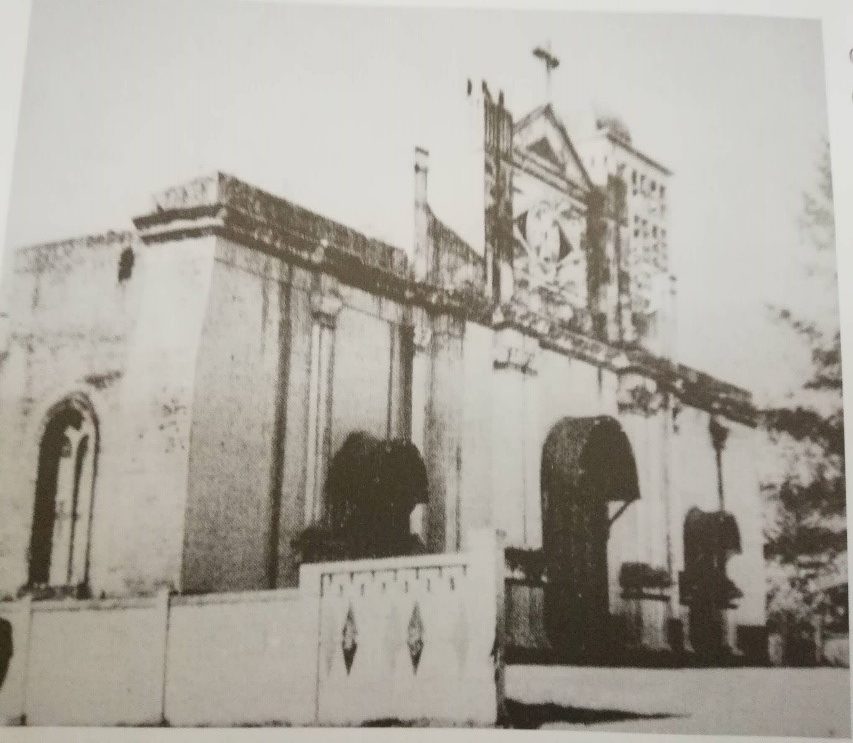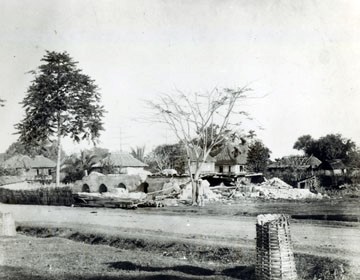The town of Binalonan served as the crossroad of different cultures such as Pangasinan, Ilocano and Cordilleran culture, thus bearing witness to the growth and development of educational institutions, connecting roads and highways, cultural exchanges and migrations.
The place of Binalonan first appeared on the early 1800’s map of Fraile Murillo Vellarde of the Dominican Order (seen from Cortes, 1975), but the place was declared as an independent municipality from Manaoag in 1834. Its declaration of municipality status has a long history of conflict and animosity between principalias, the first attempt was in 1822 but only approved by 1934. The Sto. Nino church was built in 1841 in accord to its mother parish in Manaoag. The town of Binalonan was sparsely populated and forested during the early 1800’s. How it became an agricultural district has a long history connected with political fiasco, trend in migration and a long defiance to the policies implemented during colonial period.

Sto. Nino Church that features late Baroque architecture | University of Sto. Thomas Archival collection, Espana Manila.
The location of Binalonan could have also served as a base operation for the Dominican friars as connecting link to their missions in the neighboring mountains of Benguet. Furthermore, it also served as a new home for Ilocano migrants who fled from the excruciating labor conditions of tobacco plantations in Ilocos. Unrest in the Ilocos caused by government abuses especially the levying of taxes on basi (sugar cane wine), led to social upheavals such as the Basi revolt of 1807 and the Sarrat Revolt of 1816. The difficult living condition compounded by lack of arable land, forced countless families to seek a better fortune elsewhere. Many skirted down the coasts of western Luzon, establishing pockets of Ilocano settlements in Pangasinan, Zambales, Tarlac and Nueva Ecija. Later on, Ilocanos would play an important role in the lucrative trading and businesses, becoming new anacbanuas and thus shaping Pangasinan politics.
During the Spanish period from 16th century to the 17th century, the municipality of Binalonan was classified under the hacienda jurisdiction of older Mangaldan (Mangahas and Pasalo, 2015: 66), when the hacienda system was dismantled by the King of Spain, it was classified as a barangay/sitio of Manaoag. Similar to the municipalities of San Jacinto and Manaoag, it was engaged in the cultivation of rice, corn, legumes, sugarcane and fruits. For the uncultivated lands, people of Binalonan also practiced animal husbandry, cattle-raising and fabrication of bricks (Mangahas and Pasalo,2015 :67)

Ruins of Binalonan municipal building 1890 | Filipinas Heritage Library, Ayala Museum, Makati City Philippines
During the Revolutionary period of 1896 to 1898 Binalonan and Dagupan were the bloodiest battlegrounds between Katipuneros and Spaniards. However few accounts would support Binalonan residents to have participated in overthrowing the Spanish colonial government however its patriotic role was highlighted on its efforts to resist the American rule upon learning their lessons from their encounters with revolutionary warriors of Katipunan . Binalonan became a cuartel and station (located near the Sto. Nino Church) for the loyalists who fought the Katipunan during the Revolutionary period. Binalonan served as one of the bloodiest battleground during the Revolutionary period in Pangasinan, the other one is Dagupan. The town suffered four attacks from the Katipuneros who insist that Spanish officials ought to surrender to the revolutionaries. On the fourth attempt of the Katipuneros to seize Binalonan, its residents decided to surrender and embrace their brothers and sister thereby moving the battle to Dagupan. (Quintos 1947: 57-61)
It would give us a background on the nationalist feelings that prevailed among the common people of Binalonan whereas almost 700 residents from Binalonan and neighboring towns were proven to have participated in overthrowing the American government with colonels and generals that were jailed crying for a total independence for their motherland. (Cortes 1900: 14)
Unlike the Spaniards, the Americans put emphasis on the role of public education as one of their means in pacifying the entire archipelago in accord to their doctrinal mission known as Benevolent Assimilation. One of the measures taken was the construction of public schools under the Gabaldon Act by First Philippine Assembly in 1907. In 1904, the first intermediate schools were established in Lingayen, the capital, Alaminos in the west and Asingan in the east, On 1906, the intermediate school of Asingan was transferred to Binalonan by establishing a new building with strong materials. The Gabaldon building of Binalonan was erected with a budget of 16,000, half of which was funded by the municipality while the other half came from the residents of the town. On that period, Gabaldon Building of Binalonan housed a total of 491teachers, of which 30 are Americans. (Cortes 1900: 46)
Binalonan also witnessed the progress in transport infrastructure for the construction of the road connecting Baguio to the lowlands. Since the national government decided to develop Baguio as a summer capital of the country, Dagupan railways has received budget for its project extension. The province of Pangasinan benefited from the development of infrastructure such as building the new road connecting Manila in the South and Baguio to the North. (Bulosan, 1946: 31) The road of Binalonan then served as stop-overs for American and European travelers going to Baguio.
The onset of Second Word War with the Japanese occupation made the province of Pangasinan suffered from heavy casualties and damages. Under the command of General Douglas McArthur, the 103rd infantry of the 43rd Division made an easy landing on San Fabian, however small groups of Japanese soldiers were alarmed and attempted to delay its advances towards the direction of Baguio. In Binalonan, the Japanese soldiers was reported to have dug tunnels in hills and built “an about 350 man garrison at Binalonan supported by tanks and artilleries. The battle in Binalonan lasted for a day with casualties from both sides, but the Americans were able to win Route 3 in Binalonan which connects the east, southeast and south roads.” (Cortes, 1900: 132)
Post-war Binalonan and to the present, have developed its municipality into an educational town with Guico family serving as the founding fathers of Binalonan in the 19th century. (Cortes, 1990: 156) The municipality also produced distinctive Filipinos such as the First Lady Evangelina Macaraeg Macapagal, wife of Diosdado Macapagal, first Chief Justice Manuel Moran who was hailed from Binalonan and Carlos Bulosan, Filipino labor activist, poet and a renowned author with his books read across the world, following his legacy in the United States.
Sources
- Bulosan, Carlos (1946). America is in the Heart: personal History. New York: Harcourt Brace and co.
- Cortes, Rosario (1990).Pangasinan, 1901-1986: a political, socio-economic and cultural history. Quezon City: New Day Publisher.
- Cortes Rosario (1975).Pangasinan: 1572-1800. Quezon City: New Day Publisher.
- Mangahas Fe and Pasalo, Virginia (2015. Pangasinan Pinablin dalin: history, culture and development. Lingayen, Pangasinan: Pangasinan Historical and Cultural Commission.
- Quintos, Felipe (1947). Breves relatos de la revolucion en Filipinas. Manuscript written by the author, preserved at the Filipiniana section of the University of the Philippines Diliman Main Library.
Province: Pangasinan
District: 5th District, Pangasinan
Founded: 1834
Barangays: 24
Government:
- Mayor: Hon. Ramon Ronald V. Guico IV
- Vice Mayor: Hon. Bryan Louie R. Balangue
Land Area: Total of 47.57 km2 (18.37 sq mi)
Population (2010):
- Total of 52,832
- Density of 1,100/km2 (2,900/sq mi)
ZIP code: 2436
Dialing code: 75
Income class: 1st class; partial urban
Town Fiesta: February 18-22
Products: Sugar cane, rice, feeds, cornik, basi/tuba, ornamental plants & earthen pots
Educational institutions in Binalonan are as follows:
Public Primary Schools/Elementary (22):
| North Central School | Moreno Elementary School | Sumabnit Elementary School |
| Bugayong Integrated School | San Felipe Elementary School | Pasileng Elementary School |
| Camangaan Elementary School | Sta Catalina Elementary School | Tabuyoc Elementary School |
| Capas Elementary School | Sta Maria Elementary School | Bued Elementary School |
| Casantiagoan Elementary School | Vacante Elementary School | Balisa Elementary School |
| Cili Elementary School | South Central Elementary School | Santiago Elementary School |
| Dumayat Elementary School | Balangobong – San Pablo Elementary School | Mangcasuy Elementary School |
| Linmansangan Elementary School |
Private Primary Schools/Elementary (7):
| Angel’s Learning Center | Lubic Christian Academy | Sta Fe Learning Center |
| Binalonan Nazarene Christian Academy | Math Excellence Academy of Binalonan | Holy Child Academy |
| Ovidio Vijungco Learning Institute |
Public Secondary Schools (6):
| Juan Macaraeg National High School | Batasan National High School | Sumabnit National High School |
| Sta Maria National High School | San Felipe National High School | Bugayong National High School |
Universities (3):
| University of Eastern Pangasinan | WCC Aeronautical and Technological College |
| Manantan Technical School |
Ikaw, ako, tayong lahat may banal na tungkulin
Inaasahan ng dakilang bayan natin
Sa Maykapal italaga ang mithiing kaunlaran
Tungo sa maningning na kinabukasan
Pagsikapang matuto ng bagong kaalaman
Palawakin natin ang dunong at kakayahan
Palawigin ang saklaw at ang hangganan
Ng ating adhikain at isipan
Koro:
BINALONAN ANG GALING!
Bayang dakila at magiting
Makadiyos, marunong at malinis na pamayanan
Taas noo at buong karangalan
Itinatanghal ang bayan ng Binalonan!
Bayan natin may malinis na kapaligiran
Bunga ng panatag na kalooban
Tahimik at payapang mga lansangan
Masaya at masaganang taong-bayan
(Ulitin ang Koro)
Tulay:
Isigaw! Ipagsabi! Ipagmalaki!
Bayang tinatangi bigyang dangal lagi
Paninindigan at kahusayan ng ating lahi
Sa lahat ng panahon, ating ipagbunyi
(Ulitin ang Koro)
We, your people, come before you with humility and admiration
We bow before your presence in thanksgiving and adoration
For the countless blessings that you have bestowed upon
Your beloved town, Binalonan
Almighty God,
We, your people ask for your enduring spirit
Ignite us to be strong in our faith, righteous in our work
Wise in our understanding, humble in our talk
Steadfast in our service
And united in our cause
Almighty God,
Because you have given us so much
And much is required of us to give in return
We commit to you an excellent and Godly community
A place where as strong foundation wrests on the family
A place we call our home, a haven for peace
Our beloved town, Binalonan.
This we pray in Christ’s name, Amen.
